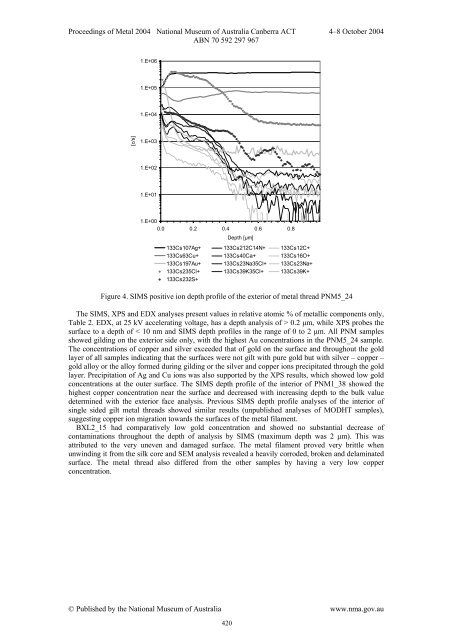Section 4: Composite artefacts (PDF 20858kb) - National Museum of ...
Section 4: Composite artefacts (PDF 20858kb) - National Museum of ...
Section 4: Composite artefacts (PDF 20858kb) - National Museum of ...
- No tags were found...
You also want an ePaper? Increase the reach of your titles
YUMPU automatically turns print PDFs into web optimized ePapers that Google loves.
Proceedings <strong>of</strong> Metal 2004 <strong>National</strong> <strong>Museum</strong> <strong>of</strong> Australia Canberra ACT 4–8 October 2004ABN 70 592 297 9671.E+061.E+051.E+04[c/s]1.E+031.E+021.E+011.E+000.0 0.2 0.4 0.6 0.8Depth [µm]133Cs107Ag+ 133Cs212C14N+ 133Cs12C+133Cs63Cu+ 133Cs40Ca+ 133Cs16O+133Cs197Au+ 133Cs23Na35Cl+ 133Cs23Na+133Cs235Cl+ 133Cs39K35Cl+ 133Cs39K+133Cs232S+Figure 4. SIMS positive ion depth pr<strong>of</strong>ile <strong>of</strong> the exterior <strong>of</strong> metal thread PNM5_24The SIMS, XPS and EDX analyses present values in relative atomic % <strong>of</strong> metallic components only,Table 2. EDX, at 25 kV accelerating voltage, has a depth analysis <strong>of</strong> > 0.2 µm, while XPS probes thesurface to a depth <strong>of</strong> < 10 nm and SIMS depth pr<strong>of</strong>iles in the range <strong>of</strong> 0 to 2 µm. All PNM samplesshowed gilding on the exterior side only, with the highest Au concentrations in the PNM5_24 sample.The concentrations <strong>of</strong> copper and silver exceeded that <strong>of</strong> gold on the surface and throughout the goldlayer <strong>of</strong> all samples indicating that the surfaces were not gilt with pure gold but with silver – copper –gold alloy or the alloy formed during gilding or the silver and copper ions precipitated through the goldlayer. Precipitation <strong>of</strong> Ag and Cu ions was also supported by the XPS results, which showed low goldconcentrations at the outer surface. The SIMS depth pr<strong>of</strong>ile <strong>of</strong> the interior <strong>of</strong> PNM1_38 showed thehighest copper concentration near the surface and decreased with increasing depth to the bulk valuedetermined with the exterior face analysis. Previous SIMS depth pr<strong>of</strong>ile analyses <strong>of</strong> the interior <strong>of</strong>single sided gilt metal threads showed similar results (unpublished analyses <strong>of</strong> MODHT samples),suggesting copper ion migration towards the surfaces <strong>of</strong> the metal filament.BXL2_15 had comparatively low gold concentration and showed no substantial decrease <strong>of</strong>contaminations throughout the depth <strong>of</strong> analysis by SIMS (maximum depth was 2 µm). This wasattributed to the very uneven and damaged surface. The metal filament proved very brittle whenunwinding it from the silk core and SEM analysis revealed a heavily corroded, broken and delaminatedsurface. The metal thread also differed from the other samples by having a very low copperconcentration.© Published by the <strong>National</strong> <strong>Museum</strong> <strong>of</strong> Australia www.nma.gov.au420
















